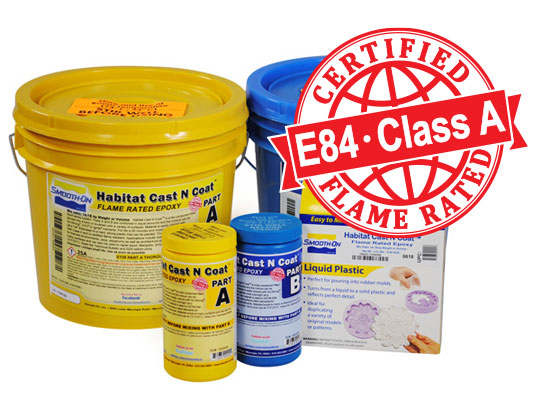Habitat Cast N Coat™

体积混合比为1A:1B。操作时间为85分钟,材料需要一晚固化时间(在室温下)。SO Strong®、UVO®或Ignite®颜色可在混合过程中添加到液体Cast N Coat™中,以形成各种颜色效果。固化的环氧树脂可以打磨并上丙烯酸涂料。
Habitat Cast N Coat™经认证可提供最高的阻燃等级(ASTM E84,A级),材料成为公共空间制作应用场合的理想选择。此外,它不含挥发性有机化合物、苯二甲酸盐或结晶二氧化硅(一种已知的致癌物质),可以安全地制作用靠近动物/爬行动物和水生生物的装饰元素。
环氧树脂与其自身或各种表面永久性粘合,可用作EPS或硬质发泡、墙板、石膏、木材、PVC等的防火保护/装饰涂层。Habitat Cast N Coat™也是一种优质的修补粘合剂,可与自身、PVC、Plexiglas®(丙烯酸)、木材、多种金属、塑料和发泡永久粘合。
说明
Preparation – Materials should be stored and used at room temperature (73°F/23°C). This product has a limited shelf life and should be used as soon as possible. Mixing should be done in a well-ventilated area. Wear safety glasses, long sleeves and rubber gloves to minimize contamination risk. Because no two applications are quite the same, a small test application to determine suitability for your project is recommended if performance of this material is in question.
Applying A Release Agent – For releasing epoxy from nonporous surfaces such as resin, metal, glass etc., use Ease Release® 200 or 205 (available from Smooth-On) to prevent adhesion.
Pre-Mixing Material – The fillers in this epoxy system will settle in the container over time. Before using, fillers need to be reconstituted by pre-mixing Part A thoroughly.
Measuring - Dispense equal amounts of Part A and Part B.
Mixing – Be sure mixing utensils are clean and free of any potential contaminants such as dirt, dust or grease. Mix Parts A and B thoroughly for at least 3 minutes with a square edged mixing stick. Be aggressive and scrape sides and bottom of mixing container several times. Use the square edge of mixing stick to bring material off of the sides of container and blend. If using a drill mixer, mix at low RPM and follow with hand mixing as directed above to ensure thorough mixing.
Important - Do not vacuum material
Pouring – If casting Habitat Cast N Coat™ into a rubber mold, pour mixture in a single spot at the lowest point of the mold. Let the mixture seek its level. A uniform flow will help minimize entrapped air. Recommended casting thickness maximum 4 in. / 10 cm.. Castings that are ¼ in. thickness or less will cure more slowly.
Thickening Cast N Coat™ Using Folding Powder® - Increase viscosity for vertical surface application by adding folding powder. For a trowelable consistency (for coating EPS foam, for example), start by adding 1 Part A, 1 Part B and 2 Parts Folding Powder®. Using a Turbine Mixer, Mix A + B thoroughly and slowly sift in Folding Powder® while still mechanically mixing. Apply to vertical surface using a disposable chip brush or trowel. Material sticks to itself, so adding layers is possible at any time. Material can be smoothed by applying alcohol or water to gloved finger tips and applying.
Curing and Heat Resistance – Habitat Cast N Coat™ will cure in 16 hours at room temperature. Elevated heat will cure epoxy faster. At an ambient temperature of 150°F/60°C, the material will cure in as little as 30 minutes. A heat gun may also be used, as long as the surface temperature of the Habitat does not exceed 212°F/100°C. Putty cured at room temperature with a minimum thickness of ½” (1.27 cm) will resist temperatures up to 131°F/55°C.
Machining – Cured castings are rigid and durable. They resist moisture, moderate heat, solvents, dilute acids and can be machined, primed/painted or bonded to other surfaces (any release agent must be removed). If machining cured Habitat Cast N Coat™ epoxy, wear dust mask or other apparatus to prevent inhalation of residual particles.
Painting – For outdoor display, cured Habitat Cast N Coat™ can be primed and then painted with acrylic enamel paints. Let paint fully dry before putting part into service.
Removing Uncured Habitat Cast N Coat™ - Remove as much uncured material from the surface as possible. Clean any residue with soap and water. Optional - Use E-POX-EE KLEENER® available from Smooth-On.